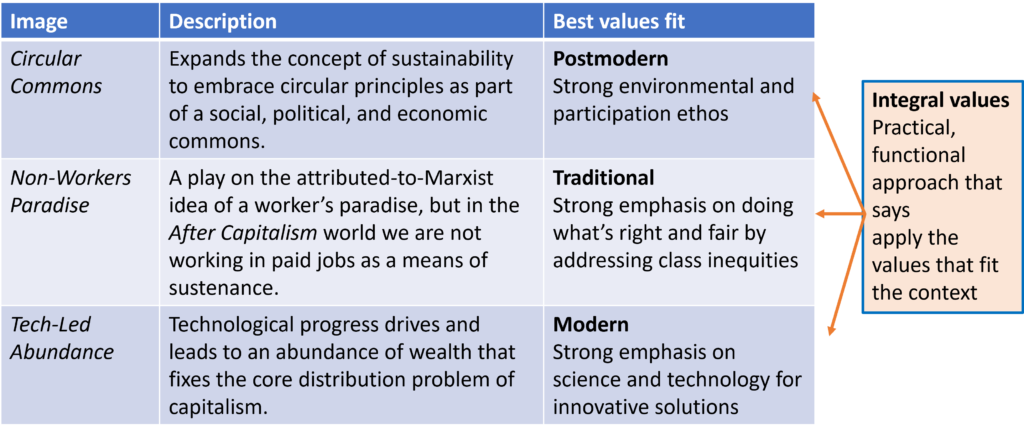The three guiding images for After Capitalism each have their own story and appeal. Today, let’s look at the values appeal. Regular readers know the scoop here but hopefully we’re bringing in some new folks to the After Capitalism world:
- Traditional: Focused on following the rules and fulfilling one’s predetermined role, with priorities such as respect for authority, religious faith, national pride, obedience, work ethic, large families with strong family ties, and strict definition of good and evil
- Modern: Focused on achievement, growth and progress, with priorities such as high trust in science and technology (as the engines of progress), faith in the state (bureaucratization), rejection of out-groups, an appreciation of hard work and money, and determination to improve one’s social and economic status
- Postmodern: Focused on the search for meaning in one’s life, with priorities such as self-expression, including an emphasis on individual responsibility as well as choice, imagination, tolerance, life balance and satisfaction, environmentalism, wellness, and leisure
- Integral: Emerging as the leading edge of values change, with a more practical and functional approach to employing values that best fit the particular situation, enabling one to pursue personal growth with an understanding and sensitivity to larger systemic considerations.

The graphic suggests the connections, but it is important to note that the relationship may also be a negative one, at least to start. People may not like the new guiding images that challenge existing approaches that they do like. But they are at least likely to be engaged by them.
The postmoderns should be most drawn to the Circular Commons image. Their strong environmental concern and participation ethos is a perfect fit. On the other hand, they may ask why we need to be so radical … isn’t my recycling enough?
The traditionals will recognize the class struggle aspect of the Non-Workers Paradise. It appeals to their sense of history that a centuries-old struggle around class warfare is finally being addressed. On the other hand, they are generally the type most resistant to change and may prefer to keep things the way they are.
The moderns will love the emphasis on science and technology of Tech-Led Abundance. They also will love the competition it encourages to develop the best solutions. On the other hand, they may see no need to move from capitalism. Their view could be that it’s been the best system for a long time, so why change?
The integrals, with their practical and functional approach, could embrace any of the three images, depending on the situation. They also have core values of being systems-oriented and visionary. They do not embrace change for the sake of change, but they are the most likely of the four types to see necessity of change.
So, which image appeals – or doesn’t appeal – to you? – Andy Hines

Andy,
I think you can find some of the elements of an integral approach in Ronfeldt & Arquilla’s WHOSE STORY WINS: The Rise of the Noosphere, Noopolitik, & Information-age Statecraft, published by RAND. Particularly look at Chapter Seven, “Hope for the Noosphere and Noopolitik: The Global Commons”. It discusses both the growing concept of a Global Commons at the World Systems/International level. They note the mesh-like application of these ideas in bottom-up movements which seek to supplant or contain Capitalism.
The parallax view of top-down policy maker’s view (Traditional+Modern top-down modification of current world system at national/international policy levels) and agents at the bottom looking to grow a bottom-up mesh-like interlinked commons systems (Postmodern peer-to-peer commons networks) has very interesting possibilities & implications for an integral vision of After Capitalism which incorporates elements of all three of the scenarios you’ve identified. PDF download here: https://www.rand.org/pubs/perspectives/PEA237-1.html